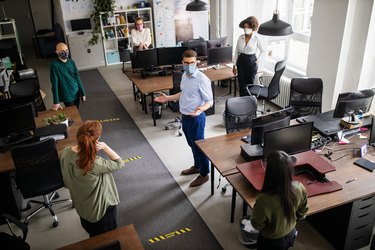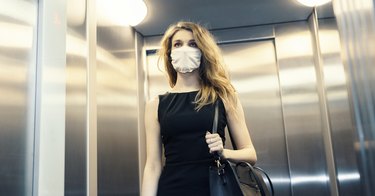
Many essential workers such as health care professionals, public transportation operators and grocery store employees continued to work onsite throughout the coronavirus pandemic. But millions of other workers are only just beginning to return to their workplace as states reopen for business.
For people who are fully vaccinated, returning to the office should be a safe endeavor — after all, other indoor activities, such as eating at restaurants and going to the movie theater, are deemed safe by the Centers for Disease Control and Prevention (CDC).
Video of the Day
Video of the Day
But workplaces may still have measures in place to reduce employees' exposure to COVID-19 and generally ease people back into a return to in-person work.
Some employers may opt to follow guidelines from the CDC, but since these are suggestions — not hard-and-fast regulations — what you can expect once you return to work depends largely on your state, local jurisdiction, the specifics of your workplace and the discretion of your employer.
Get tips on how to stay healthy, safe and sane during the novel coronavirus pandemic.
While you may be eager to get back to your pre-pandemic work routine, plan to incorporate new safety standards and hygiene habits when you do. Here's what you can do to protect yourself and others as you return to the physical workplace.
1. Get Vaccinated
Indoor activities — which put people at high-risk for COVID-19 — are safer once you are vaccinated, according to the CDC.
Visit Vaccines.gov to find a convenient location to get a COVID-19 vaccine.
Companies are legally allowed to require all employees to get vaccinated prior to returning to work, according to May 2021 guidance from the U.S. Equal Employment Opportunity Commission (EEOC).
That said, state laws may vary, according to June 2021 reporting in the New York Times, which notes that Texas, Arkansas and Florida all have laws that prevent employers from requiring vaccination proof.
If all company employees are not vaccinated, your employer has a responsibility to establish policies and practices for social distancing in the workplace, according to the CDC. This includes:
Reducing Onsite Employees
Expect that not all your co-workers will be present every day, because employers should strategize ways to have fewer people at the workplace. This could involve "staggering shifts to limit the number of employees in the workplace at the same time, which helps to avoid cross-contamination between 100 percent of workers," David Freedman, MD, a professor emeritus of infectious diseases at the University of Alabama at Birmingham, tells LIVESTRONG.com.
Encouraging Remote Work
You may also still be taking advantage of video meeting options. Your company may continue to "encourage telework for as many employees as possible, especially for those who use public transportation," Dr. Freedman says. In-person meetings should be replaced with video or teleconference calls whenever possible, per the CDC.
Tip
If you are vaccinated but still considered potentially at a higher risk for COVID-19 complications because you are immunocompromised, discuss options with your employer and advocate for telecommuting to reduce your potential exposure.
Redesigning Workspaces
Be prepared for a new office layout that helps keep you and your co-workers (or customers, when applicable) at least 6 feet apart. For example, in certain cases, physical barriers, such as sneeze guards and partitions, may be installed.
Related Reading
3. Wear Your Mask
While wearing a face covering doesn't replace the need to practice social distancing, it's the most effective strategy to keep yourself and your colleagues safe aside from getting vaccinated.
If you are unvaccinated, continue wearing a mask. That said, you can remove it "while alone in a private office or cubicle with no one else within 6 feet," Dr. Freedman says.
If you are vaccinated, you may still want to wear a mask in congested areas (think: the elevator).
4. Address Air Flow
It seems that the risk of potential airborne transmission of COVID-19 increases in confined spaces. In fact, just chatting in a closed, stagnant air environment can up your chances of infection, according to a May 2020 study in PNAS. Researchers concluded that normal talking can emit thousands of disease-carrying oral fluid droplets per second that may linger in the air for more than 8 minutes.
That's why proper ventilation is vital to stop the spread of the coronavirus in the workplace. Your employer should boost circulation and ensure that all ventilation systems are working properly, per the CDC. This will help create safe indoor air quality for the workspace.
Tip
To enhance airflow onsite, you can also “open windows and doors (only if it does not pose a safety risk) to increase circulation of outdoor air,” Dr. Freedman says.
For the safety of unvaccinated people, those spots in the office where co-workers typically congregate and interact — think break rooms, kitchens and conference rooms — should be eliminated or limited, per the CDC. To prevent overcrowding, your company should devise a system that allows for staggered use of these communal spaces, which must be cleaned and disinfected frequently.
If an in-person meeting is unavoidable, Dr. Freeman recommends:
- Putting a cap on the number of attendees
- Using use larger rooms with more personal space per participant
- Standing during the meeting, instead of sitting (this will help keep meetings short)
This also means no hanging out by the water cooler (or any other casual place for gathering) to chat with colleagues if you are unvaccinated. And, of course, wear a mask and wash your hands with soap and water before and after using shared spaces or attending a meeting.
6. Avoid Crowded Elevators

"This is the big one — elevators are really hard," Dr. Freedman says. That's because elevators and the waiting areas surrounding them are choke points. This means that they can become crowded or blocked with employees, especially during peak times like the morning rush or at the end of the workday.
To prevent elevator congestion, employers should limit capacity of elevators and enforce this rule, Dr. Freedman says. One way to do this is by staggering entry and exit times. When riding the elevator, follow these best practices, per Dr. Freedman:
- Wear a mask
- Don't touch anything (ideally there will be touchless floor requests)
- Face the walls or front doors (i.e., don't position yourself facing your fellow occupants)
Tip
If you work on a lower floor, or want to sneak in some cardio conditioning, use the stairs whenever possible in place of the elevator.
7. Be Cautious Using Bathrooms
Shared restrooms in the workplace present a unique opportunity for COVID-19 transmission in large part because you have people passing and talking to each other in confined spaces, Dr. Freedman says.
For that reason, single stall bathrooms are a better bet. Ideally there will be a "red light, green light" indicator to signal when a bathroom is in use as well as 6-feet markers (signs, tape marks on the floor or other visual cues) to designate where to stand to safely maintain social distancing while you wait to use the facilities, he adds.
Once in the bathroom, always scrub your hands with soap before you use the toilet. This helps protect others from any germs you may be carrying.
And make sure to shut the toilet cover prior to flushing. While inconclusive, preliminary research supports the possibility that COVID-19 may be found in feces, per a May 2020 paper in the International Journal of Infectious Diseases. Therefore, there's a chance that the disease-causing fecal particles could enter the air when you flush.
Lastly, once you're done cleaning your hands, use a paper towel to turn off the faucet and to avoid touching the doorknob directly on your way out of the restroom.
8. Eat Lunch Solo
If you aren't fully vaccinated yet, the safest solution is solo eating. "People should not eat together if they don't live together," Dr. Freedman says. While COVID-19 doesn't appear to be foodborne, the problem is that you can't wear a mask when you're munching on your lunch.
While it may seem lonely, noshing at your desk or on a bench outside by yourself is the best way to prevent picking up possible germs from others.
If you're going to be using an office refrigerator, seal all your food in a single bag and always wash your hands before opening packages and digging in. And while group coffee makers, water coolers or drink dispensers are convenient, consider the countless hands that have touched the handles and buttons and scrub up before you sip.
9. Practice Hand Hygiene

The risk of surface transmission of COVID-19 is low, according to the CDC, but plenty of other germs are spread through frequently touched surfaces in the workplace — like handrails and doorknobs.
Try not to touch your eyes, nose or mouth with unwashed hands at the office.
Lather with soap before and after work shifts, breaks and bathroom trips, and after blowing your nose, coughing or sneezing and putting on, touching or removing face masks, per the CDC.
10. Stay Home if You’re Sick
While this sounds like common sense, you might still feel the need to punch in — whether you feel pressure from your boss or you need the money. But showing up ill puts others at risk.
"Employers should actively encourage (through generous leave policies) employees with signs of fever or symptoms of respiratory illness to remain at home," Dr. Freedman says.
If you become ill at work, you should immediately go home, Dr. Freedman says.
You'll be required to self-quarantine and won't be able to return to the workplace until your respiratory symptoms have subsided and you're fever-free (without the aid of medication) for at least 72 hours, according to CDC guidelines. Additionally, you won't have the green light to get back to work until 10 days have passed since your signs of sickness first appeared.
If your symptoms are mild, and you are not too ill to work, you may want to ask your employer if you can work from home for the period of time when you cannot be onsite or have contact with others.
If you have access to convenient COVID-19 testing sites in your area, you can also prove that you're ready to return to the work environment safely through two consecutive negative tests performed at least 24 hours apart.
Concerned About COVID-19?
Read more stories to help you navigate the novel coronavirus pandemic:
- Centers for Disease Control and Prevention: “Interim Guidance for Businesses and Employers Responding to Coronavirus Disease 2019 (COVID-19), May 2020”
- Proceedings of the National Academy of Sciences: “Identifying Airborne Transmission as the Dominant Route for the Spread of COVID-19”
- PNAS: “The Airborne Lifetime of Small Speech Droplets and Their Potential Importance in SARS-CoV-2 Transmission”
- International Journal of Infectious Diseases: “Potential Fecal Transmission of SARS-CoV-2: Current Evidence and Implications for Public Health”
- Centers for Disease Control and Prevention: "Choosing Safer Activities"
- Vaccines.gov: "Find a COVID-19 vaccine near you"
- U.S. Equal Employment Opportunity Commission: "EEOC Issues Updated COVID-19 Technical Assistance"
- New York Times: "Yes, Your Employer Can Require You to Be Vaccinated"
- CDC: "Science Brief: SARS-CoV-2 and Surface (Fomite) Transmission for Indoor Community Environments"
Is this an emergency? If you are experiencing serious medical symptoms, please see the National Library of Medicine’s list of signs you need emergency medical attention or call 911.